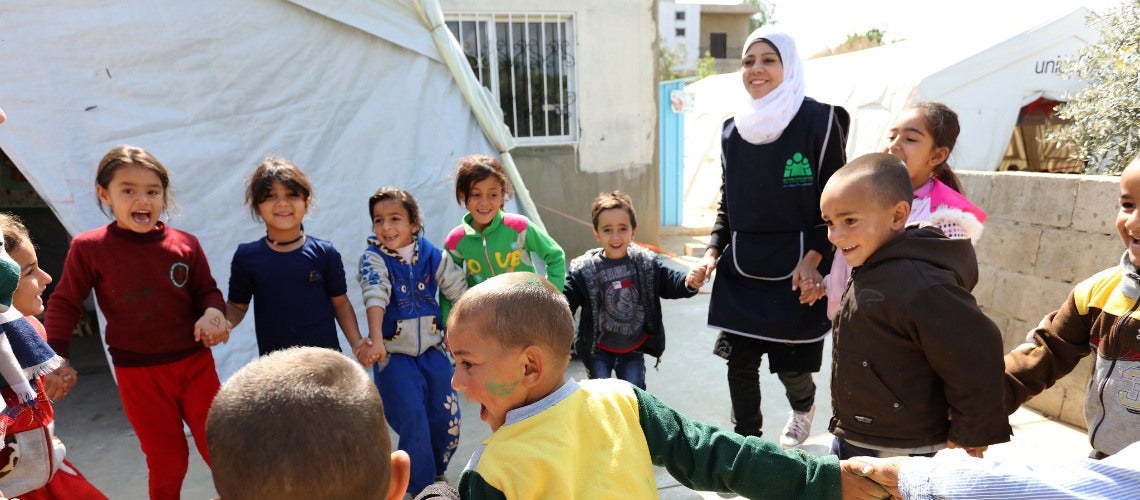 Refugee children often spend the entirety of their schooling years in forced displacement. Copyright: Dominic Chavez/World Bank
Refugee children often spend the entirety of their schooling years in forced displacement. Copyright: Dominic Chavez/World Bank
At the Global Refugee Forum this week, education stakeholders will pledge to include all refugee children in national education systems. Three major questions arise: what does inclusion mean, why does it matter and how do we get there?
Inclusion refers to refugee children attending schools that are part of the host country’s national public system, funded through government channels, and attended by both refugee and host community children together.
Why is inclusion important?
The benefits of education for refugee children are clear. Quality education can lead to higher incomes, increased self-sufficiency and reduced aid dependency. It can strengthen the ability of refugees to contribute to host country economies and promote sustainable return to and reconstruction of countries of origin. There are positive social spillovers in the form of reduced child labor, early marriage and sexual violence, and better health outcomes. Yet, education can be provided through parallel systems or national systems – why should we focus on the latter?
First, because of the protracted nature and scale of forced displacement. Refugee situations tend to last many years or even decades and refugee children will often spend the entirety of their schooling years in forced displacement. Refugee education is a developmental challenge.
Second, the current approach is inadequate. Despite decades of concerted efforts from humanitarian partners, half of school-age refugee children are out of school. Parallel systems simply cannot respond to the scale of the need.
Third, inclusion in national systems is more likely to result in formal accreditation and recognition of qualifications, making it easier for refugees to continue their education and find employment in the host country or their countries of origin.
Inclusion is also important to promote social cohesion with host communities, improve equity in the education outcomes of refugees and host populations, and strengthen service delivery for both refugees and host communities in underserved areas where refugees are often located.
Finally, inclusion is more cost effective. There can be efficiency gains from reduced transactional costs to implementing partners and from using results-based financing to improve education outcomes for refugees.
What are the challenges to inclusion?
A key challenge is adequate financing and appropriate financing instruments. A new report estimates that the annual cost of inclusive refugee education in low- and middle-income countries is $9.3 billion. In 2022, aid to refugee education amounted to $2.6 billion. While host government and philanthropic contributions accounted for another $2.4 billion, a financing gap of nearly 50 percent remains.
When financing is channeled through governments, it takes the form of investment financing whereas the bulk of the costs of education are recurrent. Host countries will be reluctant to embrace permanent solutions without adequate and predictable financing, especially after refugee children are integrated and become largely indistinguishable from host community children.
Another challenge is the status quo of existing refugee education systems. Transitioning from parallel to national systems is a monumental undertaking. It will require shifts in curriculum, changes in teacher and examination/certification policies, and transference of management and financing from humanitarian partners and NGOs to ministries of education.
Finally, there are political and social challenges to inclusion. There is limited evidence of the aggregate impacts of refugee inflows on the education outcomes of host populations; where it exists, impacts are shown to be insignificant or positive. Yet, integration of refugees into national systems could lead to social tensions resulting from perceived redistribution of limited funds and overcrowded classrooms, and policy makers have to respond to these negative perceptions.
What can we do?
- Provide more developmental financing. In low-income countries, the annual cost of inclusive refugee education is only around $300 million to reach 2.5 million children. In middle-income countries, the costs are much higher but represent less than half of one percent of public spending on education in high-income countries.
- Provide instruments for predictable, multi-year, recurrent financing for refugee education.
- Shift towards a rules-based approach to donor financing guided by the scale of need and host countries’ ability to contribute.
- Ensure that humanitarian solutions, where necessary, are inclusion-enabling and have a clear strategy for transition to national systems.
- Provide technical assistance and policy dialogue support to help transition from parallel to national education systems, including strengthening the evidence base on the impacts of refugee inflows on host populations.
To help answer “how we get there,” the World Bank, with support from the United Kingdom and in partnership with UNHCR, is launching the Inclusion Support Programme for Refugee Education (INSPIRE). Operating with a sense of urgency, INSPIRE will provide technical assistance and accelerate policy dialogues for lower income host countries to move towards full education inclusion.
As host governments pledge to open and extend their schools to refugee children at this week’s Forum, it is up to the international community to send a strong signal that we stand with them and will help finance what is ultimately a global public good – educated refugee children that will be important drivers of growth and prosperity, whether in host countries or, eventually, back home.
To receive weekly articles, sign-up here




Join the Conversation